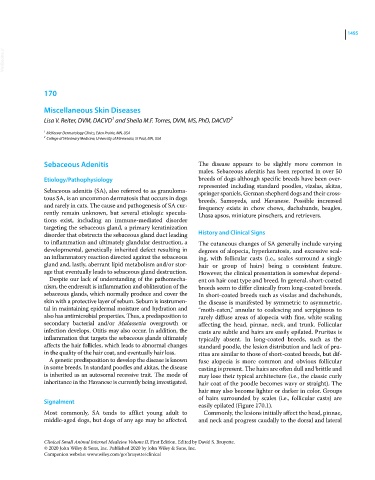Page 1557 - Clinical Small Animal Internal Medicine
P. 1557
1495
VetBooks.ir
170
Miscellaneous Skin Diseases
1
Lisa V. Reiter, DVM, DACVD and Sheila M.F. Torres, DVM, MS, PhD, DACVD 2
1 McKeever Dermatology Clinics, Eden Prairie, MN, USA
2 College of Veterinary Medicine, University of Minnesota, St Paul, MN, USA
Sebaceous Adenitis The disease appears to be slightly more common in
males. Sebaceous adenitis has been reported in over 50
Etiology/Pathophysiology breeds of dogs although specific breeds have been over-
represented including standard poodles, vizslas, akitas,
Sebaceous adenitis (SA), also referred to as granuloma- springer spaniels, German shepherd dogs and their cross‐
tous SA, is an uncommon dermatosis that occurs in dogs breeds, Samoyeds, and Havanese. Possible increased
and rarely in cats. The cause and pathogenesis of SA cur- frequency exists in chow chows, dachshunds, beagles,
rently remain unknown, but several etiologic specula- Lhasa apsos, miniature pinschers, and retrievers.
tions exist, including an immune‐mediated disorder
targeting the sebaceous gland, a primary keratinization
disorder that obstructs the sebaceous gland duct leading History and Clinical Signs
to inflammation and ultimately glandular destruction, a The cutaneous changes of SA generally include varying
developmental, genetically inherited defect resulting in degrees of alopecia, hyperkeratosis, and excessive scal-
an inflammatory reaction directed against the sebaceous ing, with follicular casts (i.e., scales surround a single
gland and, lastly, aberrant lipid metabolism and/or stor- hair or group of hairs) being a consistent feature.
age that eventually leads to sebaceous gland destruction. However, the clinical presentation is somewhat depend-
Despite our lack of understanding of the pathomecha- ent on hair coat type and breed. In general, short‐coated
nism, the endresult is inflammation and obliteration of the breeds seem to differ clinically from long‐coated breeds.
sebaceous glands, which normally produce and cover the In short‐coated breeds such as viszlas and dachshunds,
skin with a protective layer of sebum. Sebum is instrumen- the disease is manifested by symmetric to asymmetric,
tal in maintaining epidermal moisture and hydration and “moth‐eaten,” annular to coalescing and serpiginous to
also has antimicrobial properties. Thus, a predisposition to rarely diffuse areas of alopecia with fine, white scaling
secondary bacterial and/or Malassezia overgrowth or affecting the head, pinnae, neck, and trunk. Follicular
infection develops. Otitis may also occur. In addition, the casts are subtle and hairs are easily epilated. Pruritus is
inflammation that targets the sebaceous glands ultimately typically absent. In long‐coated breeds, such as the
affects the hair follicles, which leads to abnormal changes standard poodle, the lesion distribution and lack of pru-
in the quality of the hair coat, and eventually hair loss. ritus are similar to those of short‐coated breeds, but dif-
A genetic predisposition to develop the disease is known fuse alopecia is more common and obvious follicular
in some breeds. In standard poodles and akitas, the disease casting is present. The hairs are often dull and brittle and
is inherited as an autosomal recessive trait. The mode of may lose their typical architecture (i.e., the classic curly
inheritance in the Havanese is currently being investigated. hair coat of the poodle becomes wavy or straight). The
hair may also become lighter or darker in color. Groups
of hairs surrounded by scales (i.e., follicular casts) are
Signalment
easily epilated (Figure 170.1).
Most commonly, SA tends to afflict young adult to Commonly, the lesions initially affect the head, pinnae,
middle‐aged dogs, but dogs of any age may be affected. and neck and progress caudally to the dorsal and lateral
Clinical Small Animal Internal Medicine Volume II, First Edition. Edited by David S. Bruyette.
© 2020 John Wiley & Sons, Inc. Published 2020 by John Wiley & Sons, Inc.
Companion website: www.wiley.com/go/bruyette/clinical

